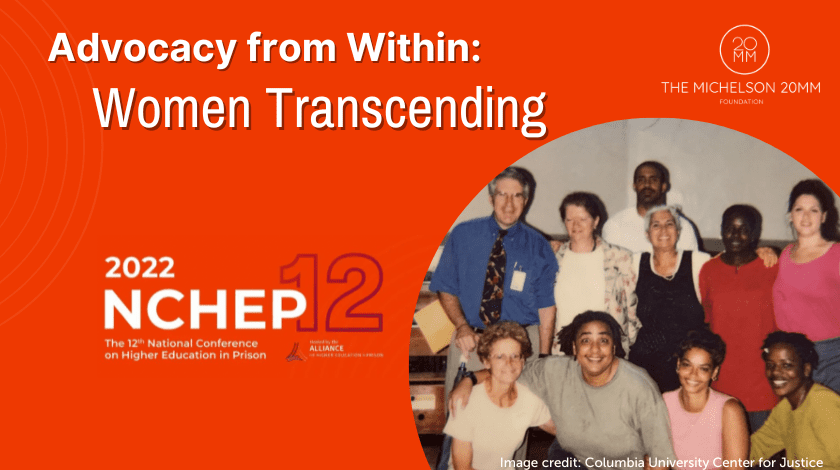By Kenia Miranda Verdugo
Recently, hundreds of individuals from institutions, organizations, foundations, and more reconvened for the National Conference on Higher Education in Prisons (NCHEP) to learn and share their experiences navigating higher education systems. As a first-year participant, I wasn’t sure what to expect. I learned about what innovative options and models different institutions from around the country are exploring in order to provide education within prisons. I also learned about the necessity of classifying postsecondary education and education-centered reentry programs as an “evidence-based practice” as opposed to a “promising practice” nationwide. One presentation in particular left me with the realization that in order to move forward, we must learn from the past.
Women Transcending Oral History Project
The federal Pell Grant was created in 1965 by Senator Claiborne Pell, D-Rhode Island, to aid low-income students for college. The 1965 bill stated that no qualifying low-income persons would be excluded. Incarcerated individuals were specifically mentioned in the bill and were intended to be included in the grant program; however, in 1994, the Violent Crime Control and Law Enforcement Act amended the Higher Education Act (HEA) to exclude individuals who were incarcerated in a state or federal penal institution from receiving federal Pell Grants, even though these grants made up less than 1 percent of total Pell spending. It was part of a wider political agenda to get tough on crime, even though research shows crime rates had begun to fall in the 1990s.
According to the American Enterprise Institute, “By 1982, 350 college-in-prison programs enrolled almost 27,000 prisoners (9 percent of the nation’s prison population), primarily through Pell Grants. By the early 1990s, it is estimated that 772 programs were operating in 1,287 correctional facilities across the nation. By 1997 it is estimated that only eight college-in-prison programs existed in the United States.” The remaining programs were those that received financial and volunteer support from other sources. One of the remaining programs was the Bedford Hills Correctional Facility College Program.
As Pell Grants were stripped from incarcerated students, the same instructors and educators who created a safe space for these students had to go into the prisons and remove textbooks and all programming materials. This left incarcerated students hopeless and confused as to what their next steps would be. For some, college instruction was an escape from the reality of prison walls, an escape from the labels society placed on them. Taking away the accessibility of Pell Grants took away the students’ hope. One group of students from the Bedford Hills Correctional Facility (BHCF) in New York were left itching for a new solution.
In March of 1996, a group of seven women from BHCF met with the Superintendent, Elaine Lord, and long-time Bedford volunteer, Theadora Jackson, to explore the possibility of creating a new college program that would be entirely supported by private funds. Within a year, a college program was created that would involve a consortium of colleges, with each member contributing faculty and/or resources for courses at BHCF. The consortium became a reality under the leadership of Dr. Regina Perrugi, president of Marymount Manhattan College (MMC), who enlisted several other college presidents as members. Barnard College, Bank Street College of Education, Manhattanville College, Mercy College, Pace University, and Sarah Lawrence College joined with MMC as members of the Consortium, and in the spring of 1997, college courses were again offered at Bedford Hills.
The Marymount Manhattan College website states: “From an initial enrollment of 39 students and three classes, the program has expanded to currently involve over 175 students per semester in the Pre-College and College Program, in addition to a solid contingency of students who have already earned their Bachelor’s degrees and serve as mentors and tutors. Annually, over 200 women register for college courses.” Incarcerated women experienced a loss of hope about their own futures and the futures of their children during the 1994 amendment to remove Pell Grants from prisons. Because of the work of seven impactful and inspiring women, hundreds of incarcerated students from BHCF are now going home with degrees.
As inspiring as this story was, it also serves as a reminder that this work is by no means easy and we will only see results through perseverance and partnership. Many of us know how difficult it is to obtain any amount of funding—now imagine attempting to fundraise from inside a prison. It has been a long, arduous road for the women of BHCF, but they leave a legacy that will not only benefit more women from BHCF, but also the children and families of those incarcerated students and graduates.
The Women Transcending Oral History Research Project will document the stories of successful organizing efforts by incarcerated women. This project will begin with an oral history of the successful organizing by the women incarcerated in Bedford Hills correctional facility to bring back college to prison following its elimination in the 1990s. The Project, led by a research collective comprised of formerly incarcerated women, university faculty, and students, will be a model that can be replicated to show the growth of women’s leadership in the struggle to end mass incarceration.
Michelson 20MM is a private, nonprofit foundation seeking to accelerate progress towards a more just world through grantmaking, operating programs, and impact investing. Co-chaired and funded by Alya and Gary Michelson, Michelson 20MM is part of the Michelson Philanthropies network of foundations.
To sign up for our newsletter, click here.

